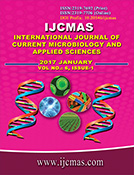


 National Academy of Agricultural Sciences (NAAS)
National Academy of Agricultural Sciences (NAAS)

|
PRINT ISSN : 2319-7692
Online ISSN : 2319-7706 Issues : 12 per year Publisher : Excellent Publishers Email : editorijcmas@gmail.com / submit@ijcmas.com Editor-in-chief: Dr.M.Prakash Index Copernicus ICV 2018: 95.39 NAAS RATING 2020: 5.38 |
Catheter-related bloodstream infection (CRBSI) is defined as the presence of bacteraemia originating from an intravenous catheter. It is one of the most frequent, lethal, and costly complications of central venous catheterization and also the most common cause of nosocomial bacteraemia. Hence the present study was undertaken to find the incidence of catheter colonisation, catheter site (local) infection and CRBSI among patients with indwelling vascular catheters in a tertiary care hospital and determine their microbiological profile. This was a cross-sectional observational study included 50 patients with an indwelling vascular catheter in Tirunelveli Medical college hospital for the period of 6 months. Catheter tips and Blood samples were collected and subjected into Culture and Antibiotic sensitivity testing. Out of the 50 patients studied, 34 isolates were obtained from the catheter tips and blood cultures. The majority of them were Coagulase negative staphylococci (44.1%) followed by Staphylococcus aureus(17.6 %) and Klebsiella pneumoniae (17.6%). Diphtheroids were 14.7 % and Pseudomonas sp were 5.9 % respectively. The incidence of CRBSI in this study was found to be 1.38 per 1000 catheter days. Of the 5 isolates that caused CRBSI, 2 were MRCONS,2 were MRSA, and one was an ESBL producing Klebsiella pneumoniae. An estimation of the rate of infection, and identification of the causative organisms will provide a clue as to the route of entry and pathogenesis of the infection, and this in turn may point to effective preventive strategies.
 |
 |
 |
 |
 |